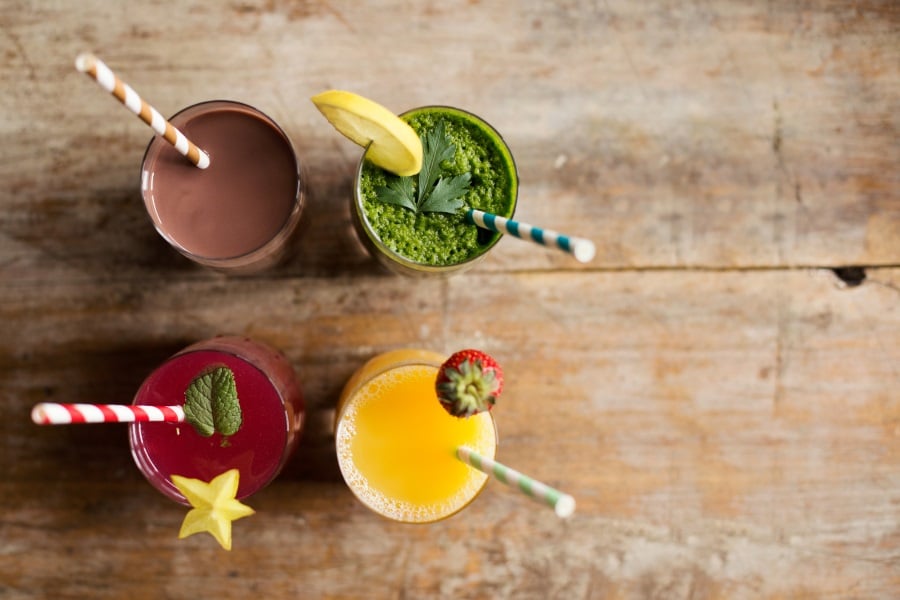
Juice, Smoothie, or Shake: Which One is a Better Choice?
Now that the holidays are over, you may be looking for ways to take off a few extra pounds. And one of the best ways, of course, is to replace some of your meals with healthy drinks. This is exactly what lots of my readers are planning to do right now. As a result, I’m getting a flood of emails asking me: What exactly is the difference between juice drinks, smoothies, and shakes—and which one is best? So today, I’ll take a look at each one.
Juice drinks
When you juice fruits and veggies, you remove the fiber, winding up with—well, juice. And juice has its pros and cons. On the plus side, juice is rich in nutrients that reach your cells quickly. If you’re not a big fan of veggies, or you simply don’t have time to cook them, juicing is a great way to get a plentiful supply of phytonutrients. Juicing is also a good way to cleanse your body of toxins. And juice is easier to digest than a smoothie if large amounts of fiber give you trouble. So what’s the down side?
If you’re tossing lots of fruits or starchy veggies like beets and carrots into your juice, you’re getting a big hit of sugar—and juicing cuts out the insoluble fiber that helps to slow down the absorption of this sugar. (It also cuts out the nutrients in that fiber.) Juicing is expensive as well, because you throw out a large percentage of your ingredients. And going overboard on juices can lead to nutritional imbalances—for example, an out-of-whack potassium-to-sodium ratio.
Moreover, juice doesn’t replace a meal. It doesn’t contain protein or healthy fats, so it doesn’t leave you satisfied for long. (Oh, and by the way, don’t even get me started on most of those commercial juices you get at the mall or at a restaurant! They’re loaded with sugar, and I don’t recommend them.)
Smoothies (blended drinks)
A smoothie, or blended drink, contains every bit of the fruits and veggies you put in the blender—so when you drink it, you supply your gut with beneficial fiber as well as the nutrients in the juice. You may also be getting more nutrition from a smoothie than you’d get from juice. For instance, one study involving grapefruit found that blending provided far higher levels of several key phytochemicals than juicing did.
You use whole fruits and veggies in blending, rather than tossing large amounts of them in the trash. And the fiber in a smoothie keeps you satisfied longer than plain juice does. What’s the “con” side? Some people simply don’t like the taste of smoothies, which can be very thick. Others discover that the fiber in them causes digestive upsets. And just as with juice, you’re not getting a full, balanced meal complete with healthy protein and fats.
Shakes
If you want to get the benefit of a healthy meal and still burn fat like crazy, shakes that start with a base of protein powder are your best bet. A shake made with a high-quality protein like my Bone Broth Protein supplies your body with the amino acids it craves—and if you toss in a little coconut or avocado, you get a good dose of healthy fats that will keep you satisfied for hours. Add some veggies, and you have everything your body needs.
For instance, check out my Supercharged Chocolate Shake here. It’s a full meal in a glass! What’s more, shakes help to keep your blood sugar level because they balance a small amount of sugar with a rich supply of protein (and fat, if you add it). This makes them a far better choice than juice drinks or fruit-laden smoothies if you have blood sugar issues. The only caution I have about shakes is not to overdo the amount of fruit you add to them. Limit your fruit to a single serving (for instance, a handful of berries, or half an apple or banana) and you won’t go wrong.
So… which drink wins?
People can get pretty passionate about whether it’s better to reach for juice, a smoothie, or a shake—but as far as I’m concerned, all three have their place in a healthy diet. Both juice drinks and smoothies help you take off pounds and provide you with those all-important phytonutrients. Shakes offer these same benefits as well as supplying you with the protein and healthy fats you need to keep your metabolism humming.
In general, I recommend shakes as a meal replacement. However, it’s fine to replace an occasional meal with juice or a smoothie. Don’t do it too often, however, or you’ll be cheating your body of key nutrients it needs—and, in the case of juice drinks in particular, you’ll be spiking your blood sugar too frequently. The trick, no matter which drink you choose, is to use the right ingredients in the right amounts—and to avoid common missteps that can make any drink less healthy. And that’s what I’ll talk about in an upcoming post— so stay tuned!
Keep thinking Big and living BOLD!








